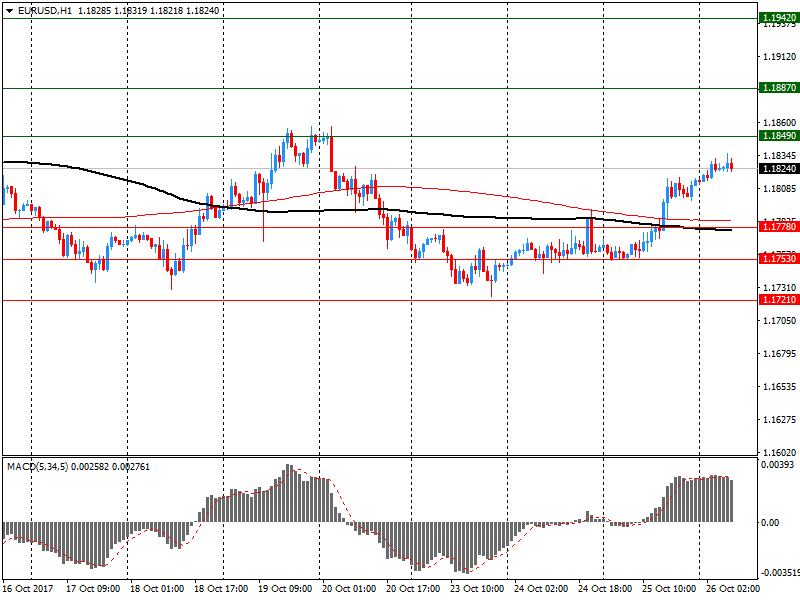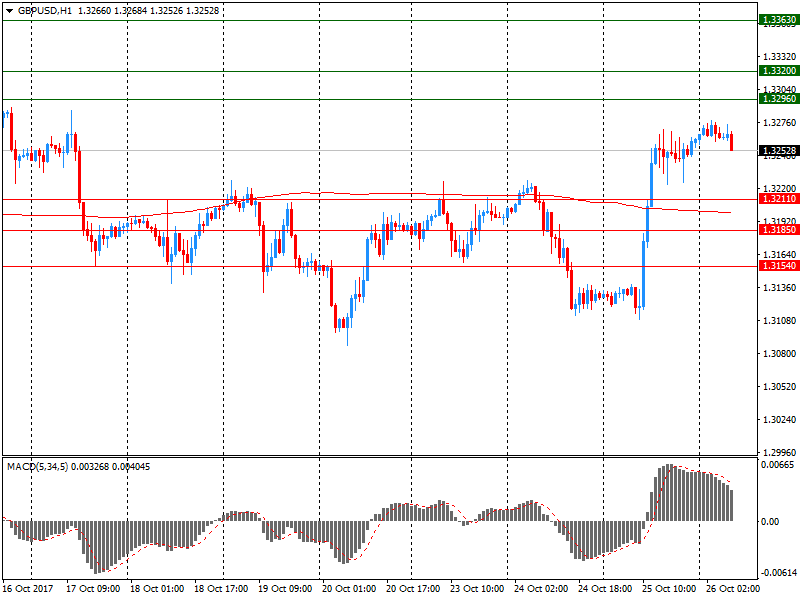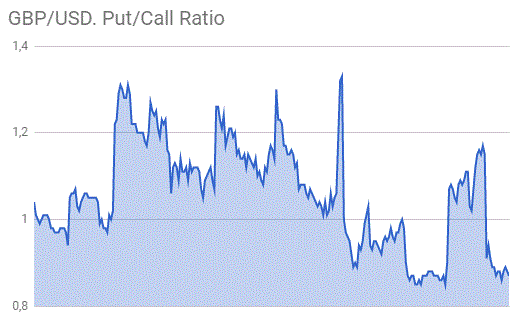Market news
-
23:30
Japan: Tokyo Consumer Price Index, y/y, October -0.2% (forecast 0.1%)
-
23:30
Japan: National Consumer Price Index, y/y, September 0.7% (forecast 0.7%)
-
23:30
Japan: National CPI Ex-Fresh Food, y/y, September 0.7% (forecast 0.8%)
-
23:30
Japan: Tokyo CPI ex Fresh Food, y/y, October 0.6% (forecast 0.5%)
-
22:27
Currencies. Daily history for Oct 26’2017:
(pare/closed(GMT +3)/change, %)
EUR/USD $1,1653 -1,39%
GBP/USD $1,3151 -0,84%
USD/CHF Chf0,99716 +0,79%
USD/JPY Y114,01 +0,29%
EUR/JPY Y132,86 -1,09%
GBP/JPY Y149,93 -0,56%
AUD/USD $0,7660 -0,57%
NZD/USD $0,6836 -0,77%
USD/CAD C$1,28479 +0,48%
-
22:06
Schedule for today, Friday, Oct 27’2017 (GMT0)
02:30 Japan Tokyo CPI ex Fresh Food, y/y October 0.5% 0.5%
02:30 Japan Tokyo Consumer Price Index, y/y October 0.5% 0.1%
02:30 Japan National Consumer Price Index, y/y September 0.7% 0.7%
02:30 Japan National CPI Ex-Fresh Food, y/y September 0.7% 0.8%
03:30 Australia Producer price index, y/y Quarter III 1.7%
03:30 Australia Producer price index, q / q Quarter III 0.5% 0.4%
09:45 France Consumer confidence October 101 101
10:15 Eurozone ECB's Peter Praet Speaks
15:30 U.S. PCE price index, q/q (Preliminary) Quarter III 0.3% 1.2%
15:30 U.S. PCE price index ex food, energy, q/q (Preliminary) Quarter III 0.90% 1.3%
15:30 U.S. GDP, q/q (Preliminary) Quarter III 3.1% 2.5%
17:00 U.S. Reuters/Michigan Consumer Sentiment Index (Finally) October 95.1 100.9
20:00 U.S. Baker Hughes Oil Rig Count October 736
-
14:30
U.S. economy seen growing 2.5 pct in third quarter vs +2.7 pct from oct 25 estimate - Atlanta Fed's GDP model
-
14:06
U.S Pending Home Sales Index flat in September
The Pending Home Sales Index, a forward-looking indicator based on contract signings, was at 106.0 in September (unchanged from a downwardly revised August figure). The index is now at its lowest reading since January 2015 (104.7), is 3.5 percent below a year ago, and has fallen on an annual basis in five of the past six months.
Lawrence Yun, NAR chief economist, says the quest to buy a home this fall continues to be a challenging endeavor for many home shoppers. "Demand exceeds supply in most markets, which is keeping price growth high and essentially eliminating any savings buyers would realize from the decline in mortgage rates from earlier this year," he said. "While most of the country, except for the South, did see minor gains in contract signings last month, activity is falling further behind last year's pace because new listings aren't keeping up with what's being sold."
-
14:00
U.S.: Pending Home Sales (MoM) , September 0% (forecast 0.2%)
-
13:45
Forex option contracts rolling off today at 14.00 GMT:
EURUSD: 1.1700 (EUR 520m) 1.1750 (610m) 1.1800 (330m) 1.1850 (350m) 1.1900 (860m) 1.1950 (1.05bln)
USDJPY:112.50 (USD 550m) 113.00 (1.87bln) 113.50 (650m) 113.60 (1.1bln) 113.70 (320m) 113.80 (300m) 114.00 (890m)
GBPUSD: Ntg of note
EURGBP: 0.8980 (EUR 520m) 0.9050 (590m)
AUDUSD: 0.7750 (AUD 370m)
-
13:07
Draghi says monetary policy decision was not unanimous
-
Discussion ranged from broad consensus to large majority
-
-
12:56
U.S unemployment claims declined more than expected last week
In the week ending October 21, the advance figure for seasonally adjusted initial claims was 233,000, an increase of 10,000 from the previous week's revised level. The previous week's level was revised up by 1,000 from 222,000 to 223,000. The 4-week moving average was 239,500, a decrease of 9,000 from the previous week's revised average. The previous week's average was revised up by 250 from 248,250 to 248,500.
Claims taking procedures continue to be severely disrupted in Puerto Rico and the Virgin Islands as a result of power outages and infrastructure damage caused by Hurricanes Irma and Maria.
-
12:54
Draghi says there were some different views on some aspects
-
Reinvestments guidance not related to interest rates
-
Didn't discuss alternative scenarios
-
Atmposphere was positive
-
All council members emphasized better conditions, growth momentum
-
Did not discuss composition of app
-
-
12:50
Draghi says underlying inflation have ticked up moderately
-
Core inflation yet to show convincing signs of sustained upward trend
-
Domestic cost pressures still subdued
-
Inflation is expected to continue to rise gradually over medium term
-
From jan, ECB will publish monthly redemptions of each component
-
-
12:46
Draghi says inflation to temporarily decline towards turn of the year
-
12:46
Draghi says very substantial degree of accommodation still needed
-
Ample degree of monetary stimulus still necessary
-
Continued monetary support provided by additional net asset purchases
-
Economic outlook conditional on continued ECB support
-
-
12:45
Draghi says recalibration of APP reflexct growing confidence in convergence towards CPI target
-
12:43
ECB's Draghi: ECB will by bonds until at least September @SigmaSquawk
-
12:30
U.S.: Continuing Jobless Claims, 1893
-
12:30
U.S.: Goods Trade Balance, $ bln., September -64.14 (forecast -63.80)
-
12:30
U.S.: Initial Jobless Claims, 233 (forecast 235)
-
12:19
Dollar adds gains on report that current Fed chief Janet Yellen out of Fed chair race
-
11:47
ECB keeps the interest rate unchanged
The interest rate on the main refinancing operations and the interest rates on the marginal lending facility and the deposit facility will remain unchanged at 0.00%, 0.25% and -0.40% respectively.
The Governing Council continues to expect the key ECB interest rates to remain at their present levels for an extended period of time, and well past the horizon of the net asset purchases.
-
11:45
Eurozone: Deposit Facilty Rate, -0.4% (forecast -0.4%)
-
11:45
Eurozone: ECB Interest Rate Decision, 0.00% (forecast 0%)
-
10:50
ECB expected to keep the interest rate at 0.00% at today’s meeting. QE tapering could be announced at the press conference
-
10:11
UK retail sales declined sharply in the year to October says CBI
The survey of 106 firms, of which 49 were retailers, showed that in the year to October, retail sales fell at the quickest rate since March 2009 - the height of the financial crisis. Overall, sales for the time of year were considered to be slightly below seasonal norms. Meanwhile, orders placed on suppliers also dropped at the fastest rate since March 2009.
Looking ahead to the next month, retailers expect sales volumes to stabilise in the year to November, but orders are expected to see a further decline, albeit at a slower pace.
-
10:00
United Kingdom: CBI retail sales volume balance, October -36 (forecast 15)
-
09:04
UK full-time workers weekly earnings fall 0.4 pct in inflation-adjusted terms in year to april 2017, first drop since 2014 - ONS
In April 2017, median gross weekly earnings for full-time employees in the UK were £550, up 2.2% from £539 in 2016.
The 2.2% growth seen this year is the joint highest since the economic downturn in 2008 (matching that seen in 2013 and 2016). Similarly the median gross weekly earnings for part-time employees also increased, from £177 in 2016 to £182 in 2017 (2.9%).
Adjusted for inflation, full-time workers' weekly earnings decreased by 0.4% compared with 2016. This is the first time since 2014 that there has been a fall in this measure and reflects a higher level of inflation in April 2017 (2.6%) compared with recent years, for example, in April 2016 inflation was 0.7%.
-
09:03
Forex option contracts rolling off today at 14.00 GMT:
EUR/USD 1.1950 1.05bn, 1.1900 850mn, 1.1850 380m, 1.1800 330m, 1.1745/50 610m, 1.1700 510m
USD/JPY 113.95/00 885m, 113.80 300m, 113.70 315m, 113.60 - 113.61 1.09bn, 113.50 645m, 113.00/05 1.86bn, 112.50 540m
AUD/USD 0.7750 365m
-
08:34
Norway Central Bank has decided to keep the key policy rate unchanged at 0.50 percent
"In Monetary Policy Report 3/17, published on 21 September 2017, the Executive Board's assessment was that there was a continued need for an expansionary monetary policy. Capacity utilisation in the Norwegian economy was assessed to be below a normal level, and inflation was expected to remain below 2.5 percent in the coming years. The Executive Board's assessment of the outlook and the balance of risks suggested that the key policy rate would remain at 0.5 percent in the period ahead.
The Executive Board's assessment is that developments so far have been broadly in line with the picture presented in the September Report. New information does not provide a basis for changing the Bank's assessment of growth in the Norwegian economy. The improvement in the labour market appears to be continuing. Inflation has been slightly lower than projected, while the krone exchange rate is somewhat weaker than projected".
"The outlook and the balance of risks for the Norwegian economy do not appear to have changed substantially since the September Report. The Executive Board therefore decided to keep the key policy rate unchanged at this meeting", says Governor Øystein Olsen.
-
08:15
Euro area M3 money supply rose 5.1% in September
-
The annual growth rate of the broad monetary aggregate M3 stood at 5.1% in September 2017, after 5.0% in August 2017.
-
The annual growth rate of the narrower aggregate M1, which includes currency in circulation and overnight deposits, increased to 9.7% in September, from 9.5% in August.
-
The annual growth rate of adjusted loans to households stood at 2.7% in September, unchanged from the previous month.
-
The annual growth rate of adjusted loans to non-financial corporations stood at 2.5% in September, compared with 2.4% in August.
-
-
08:01
Eurozone: Private Loans, Y/Y, September 2.7% (forecast 2.9%)
-
08:00
Eurozone: M3 money supply, adjusted y/y, September 5.1% (forecast 5.0%)
-
07:30
Spanish unemployment rate down to 16.38% in Q3
The number of employed persons increases by 235,900 people in the third quarter of 2017 compared to the previous quarter (1.25%) and stands at 19,049,200. In terms seasonally adjusted, the quarterly variation is 0.75%. Employment has grown in 521,700 people in the last 12 months.
The annual rate is 2.82%. - The occupation in the public sector increases this quarter by 58,300 and in the sector private it does in 177,600. In the last 12 months employment has increased in 463,500 people in the private sector and 58,200 in the public. - The total number of employees rises this quarter at 216,400.
-
06:45
Options levels on thursday,, October 26, 2017
EUR/USD
Resistance levels (open interest**, contracts)
$1.1942 (3288)
$1.1887 (3016)
$1.1849 (381)
Price at time of writing this review: $1.1824
Support levels (open interest**, contracts):
$1.1778 (2484)
$1.1753 (3411)
$1.1721 (3247)
Comments:
- Overall open interest on the CALL options and PUT options with the expiration date November, 3 is 110576 contracts (according to data from October, 25) with the maximum number of contracts with strike price $1,2000 (10174);
GBP/USD
Resistance levels (open interest**, contracts)
$1.3363 (3418)
$1.3320 (3867)
$1.3296 (2407)
Price at time of writing this review: $1.3253
Support levels (open interest**, contracts):
$1.3211 (2178)
$1.3185 (886)
$1.3154 (1738)
Comments:
- Overall open interest on the CALL options with the expiration date November, 3 is 41781 contracts, with the maximum number of contracts with strike price $1,3200 (3867);
- Overall open interest on the PUT options with the expiration date November, 3 is 36506 contracts, with the maximum number of contracts with strike price $1,3000 (3139);
- The ratio of PUT/CALL was 0.87 versus 0.88 from the previous trading day according to data from October, 25
* - The Chicago Mercantile Exchange bulletin (CME) is used for the calculation.
** - Open interest takes into account the total number of option contracts that are open at the moment.
-
06:19
Norway's labour and welfare administration cuts 2018 unemployment forecast to 2.5 pct from 2.6 pct, sees further fall to 2.4 pct in 2019
-
06:15
New Zealand has a trade balance deficit of $1.1 billion in September
Milk powder, butter, and cheese leads exports rise:
-
Goods exports rose $313 million (9.0 percent) to $3.8 billion.
-
Milk powder, butter, and cheese had the largest rise of any export commodity group in September 2017, up $175 million (28 percent) to $791 million.
-
Milk fats including butter led the rise in milk powder, butter, and cheese, up $62 million (43 percent) to $207 million, with quantity down 22 percent.
-
Milk powder rose $58 million (20 percent) in value, with quantity down 15 percent.
-
Milk and cream rose $44 million (118 percent) in value, and 41 percent in quantity.
-
Fruit exports fell $69 million (30 percent) in value, and 38 percent in quantity.
-
The fall in fruit exports was due to kiwifruit, down in both value ($70 million) and quantity (42 percent). However, for the September 2017 year, the value of kiwifruit exports rose $69 million (4.1 percent) from the previous year. The quantity of kiwifruit exports fell 2.0 percent over the same period.
The monthly trade balance was a deficit of $1.1 billion (30 percent of exports).
The average monthly deficit in September over the last five years was $980 million (28 percent of exports).
-
-
06:11
Australian import and export price indexes mixed in Q3
The Import Price Index fell 1.6% in the September quarter 2017. This follows a fall in the June quarter 2017 of 0.1%.
The fall was driven by lower prices paid for Telecommunication and sound recording equipment (-7.8%), Petroleum, petroleum products and related materials (-2.0%) and Office and automatic data processing machines (-4.7%).
Through the year to the September quarter 2017, the Import Price Index fell 0.4%, driven by Telecommunications and sound recording equipment (-15.9%).
The Export Price Index fell 3.0% in the September quarter 2017. This follows a fall in the June quarter 2017 of 5.7%
The fall was driven by lower prices received for Coal, coke and briquettes (-7.4%), Metalliferous ores and metal scrap (-1.5%) and Gas, natural and manufactured (-4.0%).
Through the year to the September quarter 2017, the Export Price Index rose 14.2%, driven by Coal, coke and briquettes (62.1%).
-
06:08
German consumer climate rose in line with expectations - GfK
Consumer mood in the first survey since the German federal elections is not sending clear signals. Both economic expectations and propensity to buy are on the rise in Germany. In contrast, income expectations fell for the second time in a row. GfK forecasts a slight decrease in consumer climate for November of 0.1 points in comparison to the previous month to 10.7 points.
Even in late fall, consumers estimate that the German economy is clearly continuing to grow. Economic expectations are rising sharply in October, with August's setback a distant memory. Additionally, propensity to buy more than makes up for last month's struggles. However, income expectations fell for the second time in a row but are still at a very good level.
-
06:00
Germany: Gfk Consumer Confidence Survey, November 10.7 (forecast 10.8)
-
00:30
Australia: Import Price Index, q/q, Quarter III -1.6% (forecast -1.4%)
-
00:30
Australia: Export Price Index, q/q, Quarter III -3.0% (forecast -6.3%)
-


